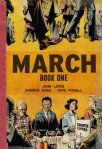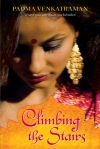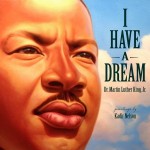 March: Book One. Written by Congressman John Lewis and Andrew Aydin. Illustrated by Nate Powell. Top Shelf Productions, 2013. 128 pages. Recommended for ages 11 and older. ISBN: 9781603093002.
March: Book One. Written by Congressman John Lewis and Andrew Aydin. Illustrated by Nate Powell. Top Shelf Productions, 2013. 128 pages. Recommended for ages 11 and older. ISBN: 9781603093002.
March: Book One is a partial autobiography in graphic form of Congressman John Lewis. Lewis was 23 when he spoke at the March on Washington in 1963. March: Book One addresses Lewis’s childhood in rural Alabama and his time as a college student in Nashville, Tennessee.
The book starts on the Edmund Pettus Bridge, and then switches to the morning of President Obama’s inauguration, when a woman and her two sons show up in Lewis’s office. The mother didn’t expect Lewis to be there. She simply wanted her son’s to see how far society had come from the 1950s and 1960s to a time when Lewis could hold congressional office and Barack Obama could be inaugurated as president. Lewis welcomes the visitors into his office and proceeds to tell the young boys about his life. The boys’ questions partially guide his reminiscences. The book switches back and forth between those reminiscences and January 20, 2009.
Lewis tells the boys that he was responsible for the family’s chickens when he was young, a job he loved. But he hated killing and eating the chickens, perhaps a foreshadowing of his later recognition of the importance of nonviolence in the civil rights movement.
Lewis talks about his fascination with Dr. Martin Luther King’s “social gospel.” Nonviolence was a primary tenant of that gospel. Jim Lawson, a member of the Fellowship of Reconciliation, was another early influence in the direction of nonviolence.
The events of the movement to desegregate lunch counters in Nashville where Lewis attended college are detailed in a fast-paced and exciting way. Towards the end of the book, Lewis speaks of his frustration with the “traditional black leadership structure,” including people such as Thurgood Marshall and organizations such as the NAACP. Lewis himself was active in founding SNCC, the Student Nonviolent Coordinating Committee, at a meeting of the Southern Christian Leadership Conference where Lawson was the keynote speaker.
This is the first graphic book I’ve read. I found that the drawings add emotion. As I sat down to read this book, I wished I had chosen another book. It seems I’ve read a number of books recently that talk about the Jim Crow South. Once I started reading, though, I realized this is a unique story of the Jim Crow South: this is John Lewis’s story. It’s tense and it’s exciting and I learned things I never knew before. I’m eager to read the next two installments in this three book autobiography.
Blog Reviews:
Good Comics For Kids
Nerdophiles
The Nonfiction Detectives
Teen Reads
Professional Reviews:







